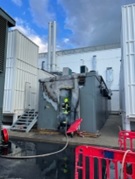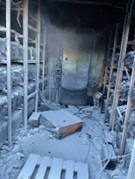
London, England

London, England

Frankfurt, Germany

Frankfurt, Germany

Frankfurt, Germany

Frankfurt, Germany

Frankfurt, Germany

Frankfurt Germany

Frankfurt, Germany

Amsterdam

Zurich

Frankfurt

Berlin

UPS module firse can be a serious event, and it is important to take immediate action to prevent the fire from spreading and to protect people and property. The specific circumstances of a UPS module fire will vary, but some common causes include:

The incident occurred during a battery discharge test on a UPS module 3 of a Juice Box 2C. The Juice Box 2C is a uninterruptible power supply (UPS) that is used to protect critical electrical equipment from power outages. The UPS module 3 is one of three modules that make up the UPS.

The JB-2C UPS was undergoing full load discharge. UPS string 1 and 2 were successfully discharged
During the discharging of UPS string 3, it was noted there was a smell coming from the battery room. The load was removed from the load bank and UPS was put into maintenance bypass. All operatives evacuated the juice box.
A small amount of smoke was then identified as coming from the battery room, which was emitting from a smoldering battery block.
The general contractor and client company called the fire brigade and proceeded to attempt to extinguish the smoldering battery with powder extinguishers. Gradually the battery began to flame at which point the GC and client withdraw from the room and ensured that all generators were out of service and cut the MV from incoming to the site in preparation for the fire brigade’s arrival, and to safeguard the rest of the equipment.
The fire continued to grow inside the room, the GC sounded the fire alarm inside the building and everyone was safely evacuated away from the fire. The fire brigade arrived on site and proceeded to extinguish the fire, the process of which washed sulfuric acid out of the juice box.
The environmental agency was called and water was contained with the use of temporary sand banks constructed by the GCs groundwork company.

The following issues were noticed during the event and corrected to maintain proper operation:
